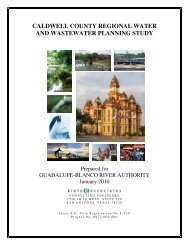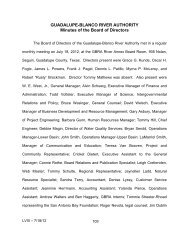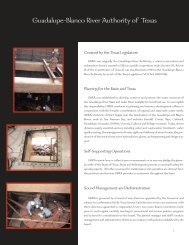Seawater Desal,continuedminerals from the water and more power to pump the water whereit is needed.A series of new gas-fired power plants could be hooked to adesal water-processing facility, using one power plant <strong>for</strong> thedesal operation and the others to generate new capacity <strong>for</strong> thegrid. Certainly, such a flagship facility — if it makes operational,economic and environmental sense — could make a big dent inthe dual power-water problem.In order to flesh out the concept, GBRA is leading the ef<strong>for</strong>tto commission a feasibility study, led by Les Shephard, Ph.D.,director of the Sustainable Energy Research Institute at theUniversity of <strong>Texas</strong> at San Antonio. “We have to answer all the keyquestions about such a project,” West said. “First, can it be done?Second, how much will it cost? Third, where should it be located?Fourth, whatare the possibleenvironmentalimpacts andhow can they bedealt with?”On April 13,2012, GBRAreleased a“request <strong>for</strong>qualifications(RFQ),” invitingengineeringfirms to submitqualifications<strong>for</strong> preparing afeasibility study<strong>for</strong> the newregional watersupply and powergeneration project.According to theRFQ, the <strong>Texas</strong>SustainableEnergy ResearchInstitute and the Center <strong>for</strong> <strong>Water</strong> Research at the University of<strong>Texas</strong> at San Antonio will serve as the Project Manager <strong>for</strong> thisproject. The deadline <strong>for</strong> firms to submit qualifications is 2 p.m.Sept. 12, 2012.Given the scope of such a study, it will not be inexpensive,West said. “Eventually, we are going to need additional funding.Feasibility is just the first part of the puzzle.”Since 2002, the TWDB has been required to submit a BiennialReport on Seawater Desalination as part of a seawater desalinationinitiative begun in April 2002. In the most recent report, submittedto the Governor’s Office in December 2010, the TWDB indicatedit had awarded about $3.3 million to fund eight studies directlyrelated to advancing seawater desalination in <strong>Texas</strong>.Two feasibility and pilot plant studies conducted by theBrownsville Public Utilities Board (BPUB) in 2004 and 2008provided sufficient data to prepare a preliminary design <strong>for</strong> a25 million-gallon-per-day plant to be installed at the Brownsvilleship channel. The estimated cost <strong>for</strong> that project was $182.4million. A more recent proposal from BPUB is to implement a2.5-million-gallon-per-day production plant at the Brownsville shipchannel without provisions <strong>for</strong> future expansion. The estimatedcost <strong>for</strong> this plant is $22.5 million. In its role as an electricpower utility, the BPUB is considering a $6 million investment inrenewable energy to be developed in conjunction with the seawaterdesalination project, according to the Biennial Report.In an article in the April 5, 2012, Houston Chronicle, StateRep. Bill Callegari (R-Katy) wrote, “More than 6,000 desalinationplants worldwidetrans<strong>for</strong>mseawater into apotable resource.Some countries,such as Israel,Australia andIndia, haveaggressivelypursueddesalination asa water supplystrategy. <strong>Texas</strong>,with its extensiveGulf coastline,has not.”Callegari alsonoted, “Althoughdesalinationpromises areliable newwater supply, it’snot predicted tobecome a majorpart of our waterportfolio. According to the state water plan, by year 2060 only 3.4percent of our water will come from desalinated sources. Of thatamount, 1.4 percent will be desalinated seawater and the other 2percent treated brackish groundwater.”(May 2009) A desalination plant in the Lanzarote, a Spanish island in the Atlantic Ocean near the coast ofAfrica.He said that the linchpin to making desalination work involvesdeveloping and using newer, innovative technologies that reduceenergy consumption and help dispose of saline brine.<strong>Water</strong> and power conversations are continuing and buildingmomentum around the state, as the continuing drought and itsaccompanying hot weather have highlighted both energy andwater shortfalls. As <strong>for</strong> a big integrated power-water desalinationproject <strong>for</strong> <strong>Texas</strong>, only a thorough, extensive study can answer thebig questions.10GBRA <strong>River</strong> Run Summer 2012
GBRA Negotiatingwith Walton InternationalGoal of Bringing More <strong>Water</strong> to the I-35/TX-130 CorridorsOfficials with the <strong>Guadalupe</strong>-<strong>Blanco</strong> <strong>River</strong> <strong>Authority</strong> (GBRA) andWalton International (Walton) signed a Letter of Intent (LOI) tonegotiate toward a plan to bring new water to the fast-developingregion of Hays, Caldwell, Comal, <strong>Guadalupe</strong> and Gonzalescounties and, together with other stakeholders, positioning it <strong>for</strong>responsible and sustainable growth. The LOI will expirein September“With this LOI, we have made substantial progress in makingGBRA’s Mid-Basin <strong>Water</strong> Supply Project viable,” Bill West, GBRAgeneral manager said. “If negotiations prove successful, Waltonwill become an anchor partner, taking a substantial amount of the25,000 acre-feet of water delivered by the project,” he added.The action brings GBRA’s Mid-Basin Project, which is arecommended strategy in the 2011 South Central <strong>Texas</strong> Regional<strong>Water</strong> Planning Group’s projects in the State <strong>Water</strong> Plan, closerto fruition. While there is much work to do over the next severalmonths, Walton and GBRA hope to work together on necessarygovernmental, environmental and regulatory permits, onconstruction, and on funding the project through available publicand private financing options. In December, the <strong>Texas</strong> <strong>Water</strong>Development Board awarded GBRA a $4.4 million loan from its<strong>Water</strong> Infrastructure Fund to finance development costs ofGBRA’s Mid-Basin Project, which comprises the use of bothsurface and groundwater.“The letter of intent we’ve signed with GBRA is the first stepin a process we hope will bring a new, reliable supply of water tothis growing region. Walton works with every community whereit does business to advance economic development, intended tobenefit everyone – the community, its residents, its businesses,and Walton as a stakeholder” said Alexa Knight, of Walton. “Oncesigned, the LOI initiates a 90-day process of negotiation withthe GBRA. We look <strong>for</strong>ward to working with all stakeholders inthe I-35 and <strong>Texas</strong> 130 corridors to ensure this course of actiondelivers a public-private partnership that leads to the developmentof vibrant communities where people can live, work and play.”U.S. Census Bureau data indicated a 61 percent increase inthe Hays County population from 2000 to 2010 and nearly a 40percent change in Comal County, West explained, noting, “Thereis no reason to believe that trend will reverse anytime soon. Acritical need has developed within our statutory district and we areworking diligently to help address it.”Walton also participates in the Greater San Marcos Partnership,which is working to bring new economic development and jobs tothese key corridors in Central <strong>Texas</strong>. They have been in business<strong>for</strong> more than 30 years,The Walton Group currently manages approximately $3.1 billionUSD of pre-development and development real estate assets,including nearly 65,000 acres of land in Alberta, Ontario, Arizona,<strong>Texas</strong>, Georgia, Virginia, Maryland, and North and South Carolinaon behalf of investors around the world, including primarilyNorth America, Europe and Asia, and <strong>for</strong> the Walton Group.Headquartered in Calgary, the Walton Group also has officesin Toronto, Hong Kong, Singapore, Kuala Lumpur (Malaysia),Scottsdale (Arizona, USA) and Hamburg (Germany).New Basin Highlights Report ReleasedThe <strong>Guadalupe</strong>-<strong>Blanco</strong> <strong>River</strong> <strong>Authority</strong> has released the Clean <strong>River</strong>s Program(CRP) 2012 Basin Highlights Report.Basin Highlights Reports are the result of a state-wide program funded by feesassessed to water rights and wastewater discharge permit holders. These fees aredivided among the CRP partners <strong>for</strong> the administration of each river basin’s program.The GBRA and Upper <strong>Guadalupe</strong> <strong>River</strong> <strong>Authority</strong> (UGRA) carry out the water qualitymanagement ef<strong>for</strong>ts in the <strong>Guadalupe</strong> <strong>River</strong> Basin under contract with the <strong>Texas</strong>Commission on Environmental Quality (TCEQ).This report is designed to give readers an overview of activities occurring in the<strong>Guadalupe</strong> <strong>River</strong> Basin and the Lavaca-<strong>Guadalupe</strong> Coastal Basin under the CRP in2011. Among the activities summarized are the return of drought conditions, theongoing lawsuit involving endangered whooping cranes, the status of the GeronimoCreek <strong>Water</strong>shed Protection Plan, the Edwards Aquifer Recovery ImplementationProgram, hydraulic fracturing activities, and many other relevant topics.To access a .pdf copy of this publication online, please visit this link:http://www.gbra.org/documents/publications/basinhighlights/2012.pdfGBRA <strong>River</strong> Run Summer 201211
















